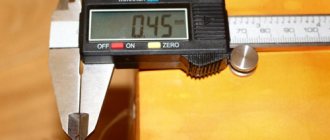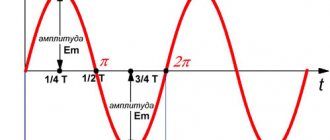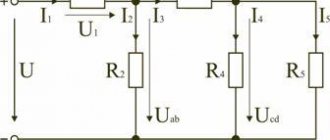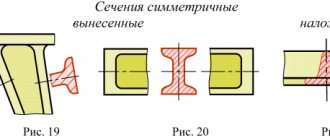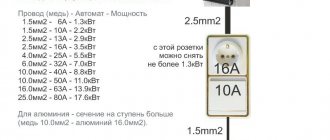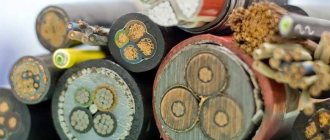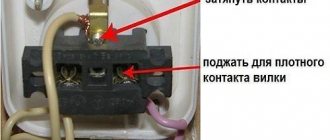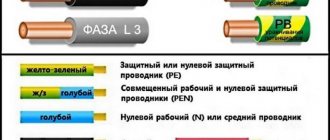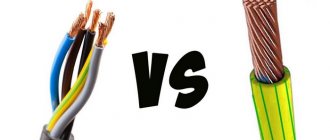Cross-sectional area as an electrical quantity
The conductivity of the wire depends on the cross-section.
As an example of the cross-section, you can consider cutting the product at an angle of 90 degrees relative to the transverse axis. The outline of the resulting figure is determined by the configuration of the object. The cable looks like a small pipe, so when cut it will come out in the form of two circles of a certain thickness. When a round metal rod is cut transversely, the shape of a circle is obtained.
In electrical engineering, the PS area will mean the rectangular cross-section of the conductor in relation to its longitudinal part. The cross-section of the cores will always be round. The parameter is measured in mm2.
Novice electricians may confuse the diameter and cross-section of elements. To determine what cross-sectional area the core has, you need to take into account its round shape and use the formula:
S = πxR2, where:
- S – area of the circle;
- π – constant value 3.14;
- R is the radius of the circle.
If the area indicator is known, it is easy to find the resistivity of the manufacturing material and the length of the wire. Next, the current resistance is calculated.
For convenience of calculations, the initial formula is transformed:
- The radius is ½ the diameter.
- To calculate area, π is multiplied by D (diameter) divided by 4, or 0.8 multiplied by 2 diameters.
When calculating, use the diameter indicator, since its incorrect selection can cause overheating and ignition of the cable.
Determination methods
There are several ways to determine cable cross-section. They all boil down to first calculating the diameter of the core, and then using small calculations to find out the final value.
Method No. 1 – Devices to help!
Today, there are engineering instruments with which you can easily determine the diameter of a wire or cable core. Such instruments include a caliper and a micrometer (click on the photo to view all the tools).
This method of determination is the most accurate, but the “other side of the coin” is the cost of the caliper/micrometer itself. The price, of course, is not astronomical, but for one-time use there is no point in purchasing this tool.
Most often, this option is chosen by professional electricians, whose lives are directly related to the installation of electrical wiring. Having a caliper, you can most accurately determine the cross-section of the wire on your own. The advantage of this technique is that you can measure the diameter of the cores even on a section of a working line (for example, in a socket).
After the measurement, you must use the following formula:
Don't forget that Pi is 3.14. To simplify the formula as much as possible, you can divide 3.14 by 4, after which the calculations will be reduced to multiplying 0.785 by the diameter squared!
Method number 2 - Using a ruler
If you do not want to spend money (and you are doing the right thing!), then we recommend using a simple “old-fashioned” method to determine the cross-section of the wire by its diameter. If you have a wire, a simple pencil and a ruler, you can find the answer in a matter of minutes. All you need is to strip the core of insulation, then tightly wind it onto a pencil (as shown in the picture) and use a ruler to measure the total length of the winding.
The essence of the method is that it is necessary to measure the total length of the wound conductor and divide it by the number of cores. The resulting value is the diameter that you need to determine.
Despite its simplicity, the calculations have their own peculiarity:
- the more cores are wound around the pencil, the more accurate the result will be, the minimum number of turns is 15;
- the turns must be pressed tightly against each other so that there is no free space, which will significantly increase the error;
- the determination must be carried out several times (changing the initial side of the measurement, turning the ruler over, etc.). Again, the more calculations, the smaller the error.
We draw your attention to the significant disadvantages of this method. Firstly, only thin conductors are suitable for measurement (due to the fact that a thick cable will be difficult to wind). Secondly, in the store before purchasing for this technique, you need to separately purchase a small piece of the product
Secondly, in the store before purchasing for this technique, you need to separately purchase a small piece of the product.
After all the measurements, you must use the same formula that we indicated above. The video shows an example of determining the cross-section of a conductor using a ruler:
Using rulers and formulas
Method #3 – Using tables
Instead of determining the cable cross-section using a formula, you can simply use ready-made tables that will reduce your time and make the result more accurate.
The table is quite simple: one column shows the diameters of the cores, the second shows their cross sections in squares.
General information about cable and wire
When working with conductors, it is necessary to understand their designation. There are wires and cables that differ from each other in their internal structure and technical characteristics. However, many people often confuse these concepts.
A wire is a conductor that has in its design one wire or a group of wires woven together and a thin common insulating layer. A cable is a core or a group of cores that has both its own insulation and a common insulating layer (sheath). Each type of conductor will have its own methods for determining cross sections, which are almost similar.
Conductor materials
The amount of energy that a conductor transmits depends on a number of factors, the main one of which is the material of the current-carrying conductors. The following non-ferrous metals can be used as the core material of wires and cables:
- Aluminum. Cheap and lightweight conductors, which is their advantage. They are characterized by such negative qualities as low electrical conductivity, a tendency to mechanical damage, high transient electrical resistance of oxidized surfaces;
- Copper. The most popular conductors, which have a high cost compared to other options. However, they are characterized by low electrical and transition resistance at the contacts, fairly high elasticity and strength, and ease of soldering and welding;
- Aluminum copper. Cable products with aluminum cores coated with copper. They are characterized by slightly lower electrical conductivity than their copper counterparts. They are also characterized by lightness, average resistance and relative cheapness.
Some methods for determining the cross-section of cables and wires will depend specifically on the material of their conductor component, which directly affects the throughput power and current strength (method of determining the cross-section of conductors by power and current).
What does cross section mean?
Before revealing the basic concept, you need to decipher the meaning of the term and understand how a wire differs from a cable. A wire is a conductor that is used to connect several sections of an electrical circuit. May have one or many current-conducting conductor elements. They, in turn, can be bare, insulated, single-core or multi-core.
Conductor cut area
The former are used in overhead electrical transmission lines. The latter are used in electrical devices, panels or cabinets. In everyday life, they are located inside electrical wiring.
For your information! Insulated and single-core conductors are used everywhere, and stranded conductors are used where bends with a small radius are needed.
What is a cross section
A cross section is a figure that is formed from a conductive section by a directional plane. The area obtained from a perpendicular cut of any type of wire is indicated in square millimeters. This is an important parameter for calculating the electrical network.
Features of electrical wires
With all the variety of cable products and a huge selection of wires for laying electrical networks, there are selection rules. It is not necessary to memorize all brands of cables and wires; you need to be able to read and decipher their markings. First, it’s worth figuring out the difference between a wire and a cable.
Wire – A conductor used to connect two sections of a circuit. May have one or more conductive wires. The veins can be:
- naked;
- isolated;
- single-core;
- stranded.
Bare lines are used where touching live wires is impossible. In most cases they are used for overhead power lines.
The insulating coating is used in one or two layers. Wires that have two or three conductors in double insulation are confused with a cable. The confusion occurs due to the fact that insulation covers each core, and on the outside there is a general polymer or other coating. Such conductors are used inside electrical devices, panels or cabinets. In everyday life, they are hidden in the wall or laid in special channels.
Insulated products are used everywhere. Depending on the degree of electrical safety of the room and the installation location, the insulation class is selected.
Read also: Knitted clothes for respectable ladies
Stranded conductors are used where small radius bends are required when laying complex routes where single-core analogues cannot pass. This type of current conductors is convenient to install in cable ducts. Single-core wires are more difficult to bend in such conditions, force must be applied, and there is a risk of damage to the wire.
For your information. Marking APPV 3*2.5 means a wire with aluminum conductors, polyvinyl chloride insulation, flat, having a dividing base. The meaning of the marking is clarified in the reference literature.
In terms of structure, a cable consists of several individually insulated strands placed in a protective outer layer of dielectric material. The space between the cores and the shell is filled with paper tapes, plastic threads or cable yarn to prevent sticking. Additionally, the product can be reinforced with armor made of tapes or steel braiding to protect against mechanical damage.
Section according to GOST or TU
A large assortment of electrical products helps to quickly solve problems associated with electrical installation work. The quality of these products plays a very important role and all products must comply with GOST requirements.
As a result, the market is oversaturated with low-quality and cheap goods that need to be double-checked before purchasing.
If the cables available in retail outlets of a suitable price do not correspond to the declared characteristics, the only thing that can be done is to purchase a wire with a reserve cross-section. The power reserve will never negatively affect the quality of electrical wiring. It would also be useful to pay attention to products from manufacturers who value their name - although they are more expensive, they are a guarantee of quality, and wiring replacement is not done so often that you can save on it.
Table for determining the cross-section of wires depending on their diameter
When purchasing, it is not always possible to correctly calculate what the actual cross-section of conductor and cable products actually is. To determine as quickly and easily as possible, you can use a special table in which the diameters of the wires and their cross-sections are entered.
Using the table is quite simple, especially since the products are marked. Knowing the realities of modern life, it would be a good idea to check whether the real characteristics correspond to the declared ones.
Working with a table
First of all, you need to take the table with you to the store. Secondly, it is necessary to measure the thickness of the wire core using any method (presented above). After this, the readings are compared with the table. If the results (although an error is possible) are close in value to those indicated in the table, then we can safely talk about the quality of conductor and cable products.
Stated sizes do not always correspond to real ones
If the values differ significantly (by 20 percent), then we can say that the manufacturer is either irresponsible or skimping on materials. Naturally, it is worth talking about low-quality products, and it is better not to buy them.
The quality of the product can be indicated by its price. Rather than high-quality products manufactured using technology in compliance with the requirements, such a product always costs more. Here, as in any other cases, you should not save money, since our safety depends on the quality of cable and conductor products.
When purchasing a wire or cable, you should visually inspect the insulating coating. As a rule, cheap products that have a reduced cross-section of conductors may also have a reduced thickness of the insulating sheath. In this case, you cannot count on long-term and reliable operation of the electrical wiring in the house.
Calculation goals
Cross section of wires for lighting
It is necessary to calculate the parameters of the cross-sectional area of the conductor for several purposes:
- obtaining the required amount of electricity to power household appliances;
- eliminating overpayments for unused energy;
- wiring safety and fire prevention;
- the ability to connect high-power equipment to the network;
- prevention of melting of the insulating layer and short circuits;
- proper organization of the lighting system.
The optimal wire cross-section for lighting is 1.5 mm2 for the line, 4-6 mm2 for the input.
Dependence of current, power and core cross-section
It is not enough to measure and calculate the cross-sectional area of the cable based on the diameter of the core. Before installing wiring or other types of electrical networks, it is also necessary to know the capacity of the cable products.
- When choosing a cable, you must be guided by several criteria:
- the strength of the electric current that the cable will pass;
- consumer power;
- current load exerted on the cable.
Power
The most important parameter during electrical installation work (in particular, cable laying) is throughput. The maximum power of electricity transmitted through it depends on the cross-section of the conductor. Therefore, it is extremely important to know the total power of the energy consumption sources that will be connected to the wire. Typically, manufacturers of household appliances, appliances and other electrical products indicate on the label and in the documentation accompanying them the maximum and average power consumption.
For example, a washing machine can consume electricity ranging from tens of W/h during rinsing mode to 2.7 kW/h when heating water.
Accordingly, a wire with a cross-section that is sufficient to transmit electricity of maximum power must be connected to it. If two or more consumers are connected to the cable, then the total power is determined by adding the limit values of each of them. The average power of all electrical appliances and lighting devices in an apartment rarely exceeds 7500 W for a single-phase network. Accordingly, the cable cross-sections in the electrical wiring must be selected to this value.
It is recommended to round the cross-section towards higher power due to a possible increase in power consumption in the future. Typically, the next largest cross-sectional area from the calculated value is taken. So, for a total power of 7.5 kW, it is necessary to use a copper cable with a core cross-section of 4 mm2, which is capable of transmitting about 8.3 kW. The cross-section of the conductor with an aluminum core in this case must be at least 6 mm2, passing a current power of 7.9 kW.
Calculation of the cross-section of a stranded conductor
Stranded wire consists of several individual wires. Its cross section is calculated as follows:
- The indicator of the cross-sectional area of one core is found.
- Cable cores are recalculated.
- The quantity is multiplied by the cross-section of one core.
When connecting a stranded conductor, its ends are crimped with a special sleeve using crimping pliers.
Tables for selecting a suitable conductor
A convenient and practical option for selecting the desired wire (cable) is to use special tables that indicate the diameters and cross-sections relative to the power and/or currents carried.
Having such a table at hand is an easy and simple way to quickly determine the conductor for the required electrical installation. Determining the required values using a classic table is one of the most convenient ways to select the required conductor during installation work. Considering that traditional conductors for electrical installations are products with copper or aluminum conductors, there are tables for both types of metals.
Also, tabular data often presents values for voltages of 220 volts and 380 volts. Plus, the installation conditions are taken into account - closed or open wiring. In fact, it turns out that one sheet of paper or a picture loaded into a smartphone contains voluminous technical information that allows you to do without the above-mentioned mathematical (linear) calculations.
Moreover, many manufacturers of cable products, in order to make it easier for the buyer to choose the right conductor, for example, for installing sockets, offer a table in which all the necessary values are entered. All that remains is to determine what load is planned for a specific electrical point and how the installation will be performed, and based on this information, select the correct wire with copper or aluminum conductors.
What is the cross section measured in?
After determining the diameter using the indicated methods, the cross-sectional area can be determined using a formula or a special table. It is measured in square millimeters. This unit of measurement is derived according to the Unified International System of Measurements.
You may be interested in this The danger of step tension
Unit of measurement
At the same time, the cut of the vein was always round.
Electric current (wire diameter)
Quite often you can encounter a situation where the power of electrical equipment and equipment is not known to the owner due to the absence of this characteristic in the documentation or the loss of the necessary documents and labels. There is always a way out. For this situation, it is as follows: make the calculation using the formula yourself. Power is determined by the formula:
P = U*I,
Where:
P – power, measured in watts (W);
I – electric current strength, measured in amperes (A);
U is the applied electrical voltage, measured in volts (V).
When the strength of the electric current is unknown, it can be measured with control and measuring instruments: an ammeter, a multimeter, and a clamp meter.
After determining the power consumption and electric current, you can use the table below to find out the required cable cross-section.
Measuring with pliers
| Wire cross-section. | Electrical voltage 220 V | Electrical voltage 380 V |
| Current strength A; Power, kWt | Current strength A; Power, kWt | |
| 2,5 | 27 5,9 | 25 16,5 |
| 4 | 38 8,3 | 30 19,8 |
| 6 | 50 11 | 40 26,4 |
| 10 | 70 15,4 | 50 33 |
| 16 | 90 19,8 | 75 49,5 |
| 25 | 115 25,3 | 90 59,4 |
| 35 | 140 30,8 | 115 75,9 |
| 50 | 175 38,5 | 145 95,7 |
| 70 | 215 47,3 | 180 118,8 |
| 95 | 260 57,2 | 220 145,2 |
| 120 | 300 66 | 260 171,6 |
Features of self-calculation
Independent calculation of the longitudinal section is performed on a core without an insulating coating. A piece of insulation can be moved or removed on a piece purchased specifically for testing. First you need to determine the diameter and find the cross section using it. Several methods are used for the work.
Using a caliper
The method is justified if the parameters of a truncated or defective cable are measured. For example, VVG may be designated as 3x2.5, but in fact be 3x21. Calculations are made as follows:
- The insulating coating is removed from the conductor.
- The diameter is measured with a caliper. You will need to place the wire between the legs of the instrument and look at the scale markings. The integer value is on top, the decimal value is on the bottom.
- Based on the formula for finding the area of a circle S = π (D/2)2 or its simplified version S = 0.8 D², the cross section is determined.
- The diameter is 1.78 mm. Substituting the value into the expression and rounding the result to hundredths, we get 2.79 mm2.
For domestic purposes, you will need conductors with a cross section of 0.75; 1.5; 2.5 and 4 mm2.
Using a ruler and pencil
Calculating PS using a ruler and pencil
If you don't have a special meter, you can use a pencil and ruler. Operations are performed with the test image:
- An area of 5-10 cm is cleared of the insulating layer.
- The resulting wire is wound around a pencil. Full turns are laid tightly, there should be no space between them, the “tails” are directed up or down.
- Ultimately, a certain number of turns should be obtained; they need to be counted.
- The winding is applied to the ruler so that the zero division coincides with the first winding.
- The length of the segment is measured and divided by the number of turns. The resulting value is the diameter.
- For example, it turned out 11 turns, which occupy 7.5 mm. When dividing 7.5 by 11, 0.68 mm is the cable diameter. The cross section can be found using the formula.
The accuracy of the calculations is determined by the density and length of the winding.
Table of correspondence between wire diameter and cross-sectional area
If it is not possible to test the diameter or make a calculation when purchasing, you can use a table. The data can be photographed, printed or transcribed, and then used to find the standard or popular core size.
| Cable diameter, mm | Conductor cross-section, mm2 |
| 0,8 | 0,5 |
| 0,98 | 0,75 |
| 1,13 | 1 |
| 1,38 | 1,5 |
| 1,6 | 2 |
| 1,78 | 2,5 |
| 2,26 | 4 |
| 2,76 | 6 |
| 3,57 | 10 |
When purchasing an electrical cable, you will need to look at the parameters on the label. For example, VVNG 2x4 is used. The number of cores is the value after “x”. That is, the product consists of two elements with a cross section of 4 mm2. Based on the table, you can check the accuracy of the information.
Most often, the cable diameter is smaller than stated on the package. The user has two options - use a different one or choose a cable with a larger cross-sectional area in diameter. Having chosen the second one, you will need to check the insulation. If it is not solid, thin, or varies in thickness, choose products from another manufacturer.
Why do you need to specify cable cross-sections?
On most wires and cables, the manufacturer is required to apply markings indicating their type, the number of conductors and their cross-section. If the wire is marked as 3x2.5, this means that the diameter of the wire is 2.5 mm². Actual values may differ from those indicated by approximately 30%, because some types of wiring (in particular PUNP) are produced according to outdated standards, which allow an error of the indicated number of percent and generally it appears on the smaller side. As a result, if you use a cable with a smaller cross-section than the calculated one, then the effect for the wire will be approximately the same if a thin polyethylene hose were connected to a fire hydrant. This can lead to dangerous consequences: overheating of the electrical wiring, melting of the insulation, and changes in the properties of the metal. Therefore, before making a purchase, it is imperative to check that the cross-sectional area of the conductor does not differ from that declared by the manufacturer.
Ways to find out the real diameter of the wire
The easiest and most accurate method to measure the diameter of a wire strand is to use special tools such as a caliper or micrometer (electronic or mechanical). In order for the measurement to be accurate, the wire being measured must be cleared of insulation so that the tool does not cling to it. You also need to inspect the tip of the wire so that it is free of kinks - sometimes they appear if the wire is cut through with blunt pliers. Once the diameter is measured, you can begin to calculate the cross-sectional area of the wire core.
A micrometer will give a more reliable reading than a caliper.
If you don’t have an accurate measuring tool at hand, there is another way to find out the cross-section - you will need a screwdriver (pencil or any tube) and a measuring ruler. You will also have to buy at least one meter of wire (50 cm is enough, if they sell that much) and remove the insulation from it. Next, the wire is wound tightly, without gaps, onto the tip of a screwdriver and the length of the wound section is measured with a ruler. The resulting winding width is divided by the number of turns and the result will be the required diameter of the wire, by which you can already search for the cross-section.
How to take measurements is shown in detail in this video:
What formulas should you use?
What such a cross-section of a wire is known from the basics of geometry or drawing is the intersection of a three-dimensional figure with an imaginary plane. At the points of their contact, a flat figure is formed, the area of which is calculated by suitable formulas. The wire core is most often cylindrical in shape and has a circle in cross-section; accordingly, the cross-section of the conductor can be calculated using the formula:
S = ϖ R²
R – radius of the circle, equal to half the diameter;
ϖ = 3.14
There are wires with flat conductors, but there are few of them and it is much easier to find the cross-sectional area of them - just multiply the sides.
To get a more accurate result you need to keep in mind:
- The more turns (there should be at least 15) screwed onto the screwdriver, the more accurate the result will be;
- There should be no distance between the turns; due to the gap, the error will be higher;
- You need to take several measurements, changing its beginning each time. The more there are, the higher the accuracy of the calculations.
The disadvantage of this method is that thin conductors can be used for measurements; it will be difficult to wind a thick cable.
Determine the wire cross-section using the table
Using formulas does not give a guaranteed result, and as luck would have it, they are forgotten at the most necessary moment. Therefore, it is better to determine the cross section according to the table where the calculation results are summarized. If you manage to measure the diameter of the core, then the cross-sectional area of the wire can be viewed in the corresponding column of the table:
If you need to find the total diameter of a stranded cable core, you will have to separately calculate the diameter of each wire and add the resulting values. Then everything is done in the same way as with a single-wire conductor - the result is found using a formula or table.
When measuring the cross-section of a wire, its core is carefully cleaned of insulation, since it is possible that its thickness will be greater than the standard. If for any reason there is doubt about the accuracy of the calculations, then it is better to choose cables or wires with a power reserve.
To approximately find out the cross-section of the wire that will be purchased, you need to add up the power of the electrical equipment that will be connected to it. Power consumption must be indicated in the device passport. Based on the known power, the total current that will flow through the conductor is calculated, and based on it, the cross-section is selected.

